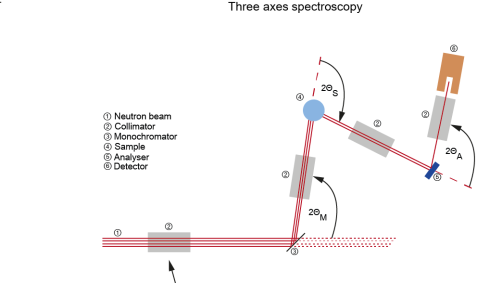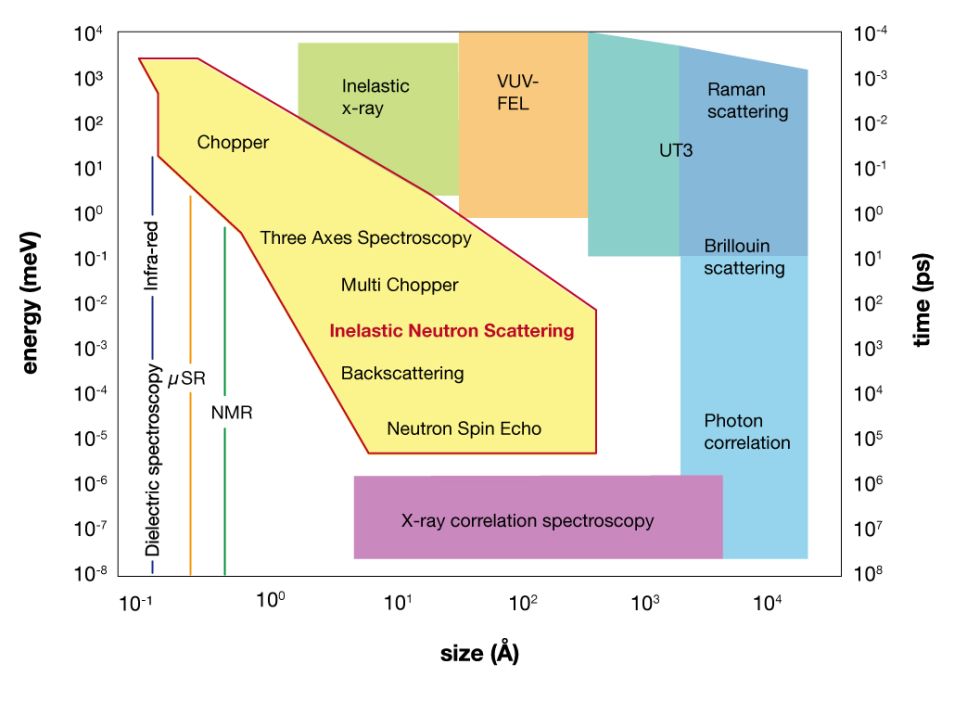MLZ is a cooperation between:
 > Technische Universität München
> Technische Universität München > Helmholtz-Zentrum Hereon
> Helmholtz-Zentrum Hereon
 > Forschungszentrum Jülich
> Forschungszentrum Jülich
MLZ is a member of:
 > LENS
> LENS > ERF-AISBL
> ERF-AISBL
MLZ on social media:

MLZ (eng)
Lichtenbergstr.1
85748 Garching
Inelastic Scattering
Inelastic neutron scattering is defined by an exchange of energy between the neutron and the sample, and thereby allows the investigation of dynamic processes. The physical phenomena include diffusional or hopping motions of atoms, the rotational modes of investigated molecules, sound modes and molecular vibrations, magnetic excitations and electronic transitions.
Neutron spectrometers obtain information on atomic and molecular movements over length scales ranging from few angstroms to ten nanometers, and over timescales from tens of picoseconds up to almost a microsecond.
Three axes spectrometers (PANDA, PUMA, TRISP, MIRA, KOMPASS)
A three axes spectrometer (TAS) is defined by the three independent axes of the instrument: monochromator (1st axis), sample (2nd axis) and analyser (3rd axis). At the monochromator, built of known crystals, Bragg’s law is used to select the energy Ei of the neutrons which hit the sample and interact with it. To explore the topics of interest, the sample needs to be oriented along the requested crystallographic directions. After the sample, the analyser is positioned in front of the detector. The neutrons that are scattered by the sample and having a particular energy Ef are selected by the analyser and counted in the detector. The energy difference ΔE = Ef – Ei is the energy gain or loss of the neutrons due to their interaction with the sample.
Due to the excellent resolution in momentum and energy (µeV…meV) as well as low background of TAS instruments, they are ideally suited for the investigation of collective excitations like phonons (lattice vibrations) or magnons (spin excitations) in single crystal materials. Typical research topics include for example spin- und vibron dynamics in superconductors, multiferroics, thermoelectric materials and related compounds, spin waves in magnetic systems and low-dimensional magnets for quantum computing.
Time-of-flight spectrometers (DNS, TOFTOF, TOPAS)
In a time-of-flight instrument the energy of the neutron is determined by the ‘time-of-flight’ the neutrons need to travel a well-defined distance. A monoenergetic neutron pulse collides with the sample. During the scattering process, the neutron may exchange energy with the sample. Its final energy is determined from the arrival time at the detectors.
Typical applications include motions in soft matter materials or biological samples, atomic diffusion in liquid metal alloys or melts or low frequency dynamics in disordered glassy materials or hydrogen motion in hydrogen storage materials.
Backscattering spectrometers (SPHERES)
Backscattering spectrometers achieve an energy resolution below 1 μeV by using filtering incoming and scattered neutrons through Bragg reflection under 180°. This gives access to molecular processes on a nanosecond scale.
Typical applications include studying hyperfine interactions, rotational tunnelling, hydrogen diffusion, dynamics of supercooled liquids, relaxation in polymers and proteins.
Spin-echo spectrometers (J-NSE, RESEDA, TRISP)
The neutron spin-echo spectrometer uses the precession of the neutron spin in a magnetic field as a very precise stop-watch to detect tiny energy exchanges with the sample. When the polarized neutron beam (i.e. all magnetic moments point in one direction) enters the magnetic field, the spins start to rotate around the field direction. After the scattering at the sample, the neutrons pass through the exact opposite magnetic field. If elastic scattering takes place, the original polarization is recovered. Small energy losses and gains result in a reduced polarization that yields rather indirect information about sample dynamics on a nanosecond scale.
Typical applications include looking at the motion of polymer chains in the melt or in solution, domain motions of proteins or fluctuations of surfactant membranes in microemulsions in soft matter systems as well as the dynamics of spin glasses in hard matter systems.
MLZ is a cooperation between:
 > Technische Universität München
> Technische Universität München > Helmholtz-Zentrum Hereon
> Helmholtz-Zentrum Hereon
 > Forschungszentrum Jülich
> Forschungszentrum Jülich
MLZ is a member of:
 > LENS
> LENS > ERF-AISBL
> ERF-AISBL
MLZ on social media:




